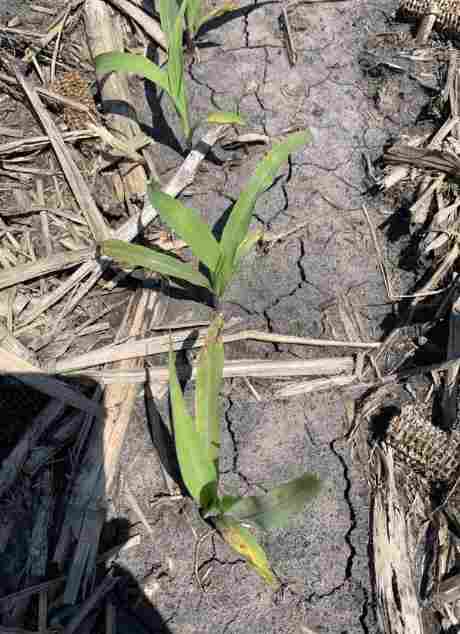By Alison Robertson
Earlier this week I was out in corn fields "helping" my lab crew collect disease data. The corn was not looking great but hopefully it has perked up with the past few days of sun and warmth. I know I have!
I noticed in my corn-on-corn fields anthracnose leaf blight on the lower leaves of the seedlings (Fig. 1). This was no surprise, since corn residue is a source of inoculum. What do I mean by that? The fungus that causes anthracnose leaf blight survives in corn residue. When conditions are wet in the spring, the fungus produces spores in a gelatinous matrix on the residue. Rain drops from spring rains splash the spores onto nearby corn seedlings. A study in Wisconsin reported a positive association between corn residue cover in the spring and anthracnose leaf blight (Jirak-Peterson and Esker, 2011). Anthracnose leaf blight is usually not observed on corn-on-soybean fields.

Fig. 1. Symptoms of anthracnose on the bottom leaves of corn seedlings in a corn-on-corn field in Central Iowa.
Of course, the fungus that causes anthracnose leaf blight in the spring, also causes stalk rot at the end of the growing season. Note however, that the Wisconsin study found no relationship between anthracnose leaf blight and stalk rot. In other words, just because anthracnose leaf blight is present in a field, this does not mean that stalk rot will be a problem. There are a couple of reasons why this may be so. Resistance to anthracnose leaf blight and resistance to stalk rot are controlled by different genes. Thus a field where anthracnose leaf blight is prevalent may not have stalk rot issues at the end of the season if the hybrid has resistance to the anthracnose fungus. Jirak-Peterson and Esker (2011) reported stalk rot incidence (percent of plants with stalk rot symptoms) was greater in plots that were chisel plowed compared to no-till plots. Another study from Texas found the fungus entered through corn roots and caused a systemic infection (Sukno et al 2008). Since there was no relationship between leaf blight and stalk rot in their study, Jirak-Peterson and Esker suggested that chisel plowing, which buries anthracnose-infested residue and puts it in the vicinity of corn roots, may contribute to stalk rot. More research is needed to understand what the source of inoculum is for anthracnose stalk rot.
Should I include a fungicide with my post-emergent herbicide to control anthracnose leaf blight?
No. Firstly, in my experience, once we get to canopy closure, it is rare to see anthracnose leaf blight on Iowa. The bottom five leaves that do get infected as a seedling die and do not contribute to corn yield. Moreover, as discussed above, there is little evidence they contribute to stalk rot either.
Secondly, several years of studies across the U.S. have reported little yield benefit to applying a fungicide. Wise et al. (2019) found the mean yield response observed from an application of a fungicde at VT was 2.9 times greater than an application at V6, and consequently the probability of return on investment from a fungicide application at VT was greater than one at V6.
Source : iastate.edu